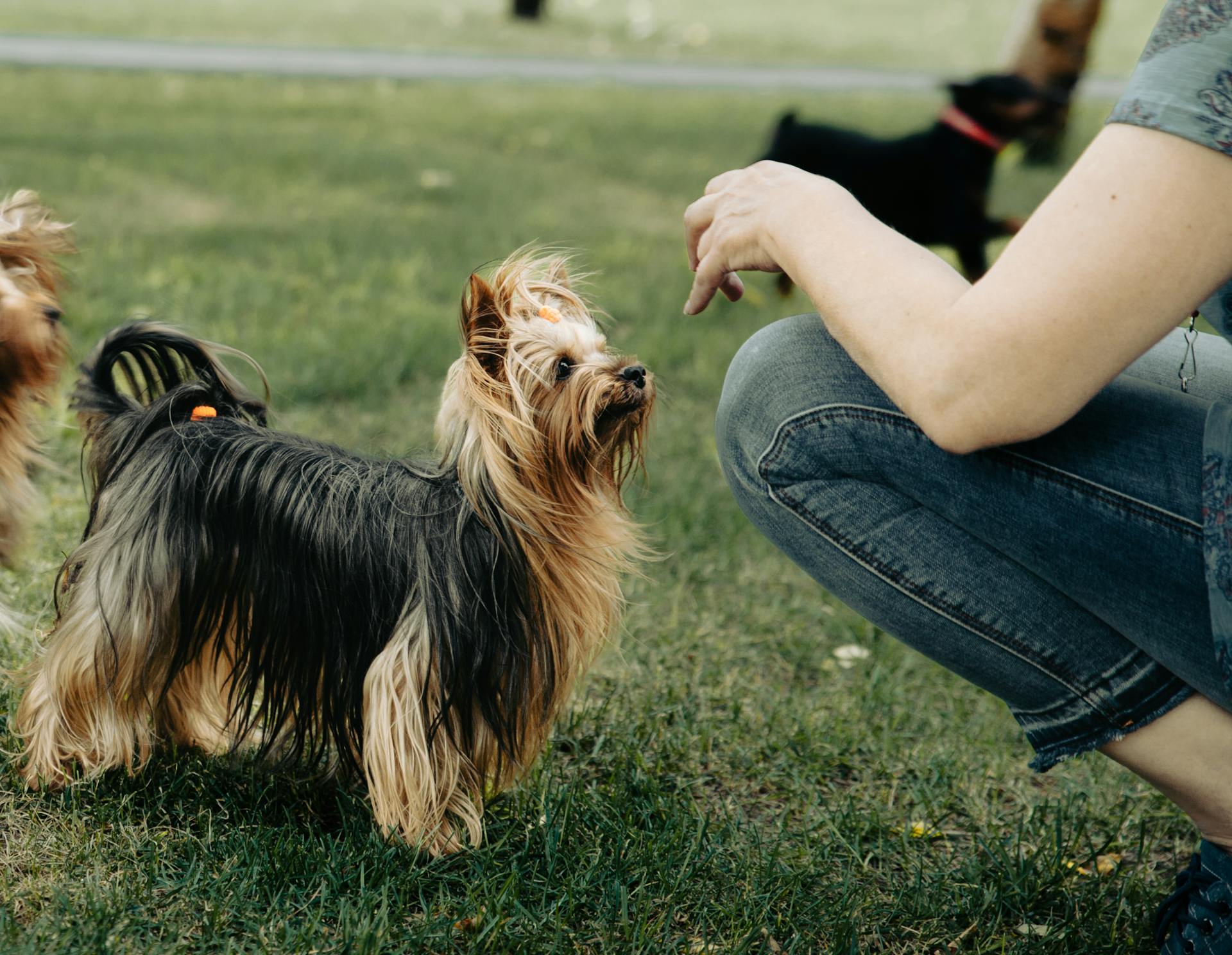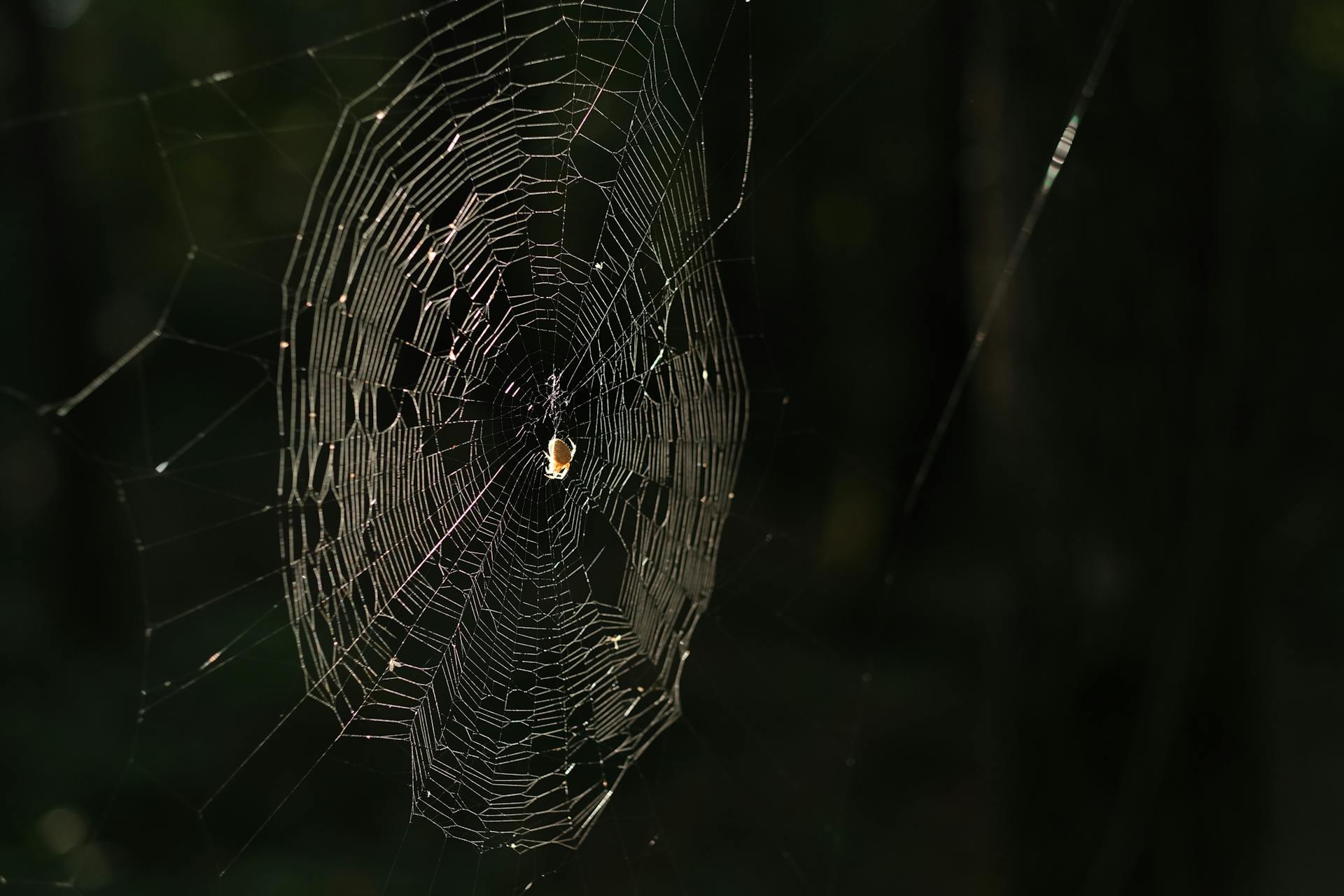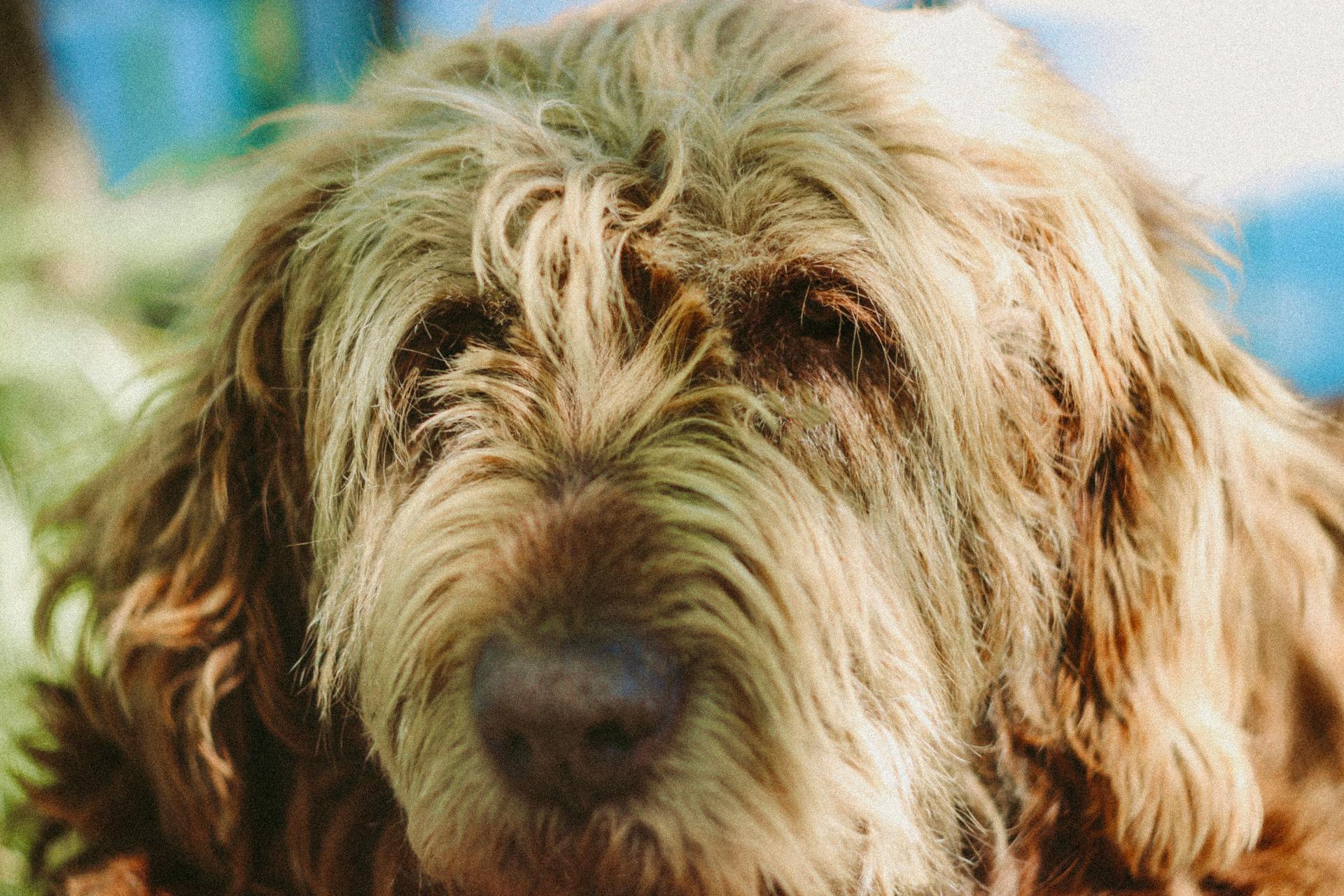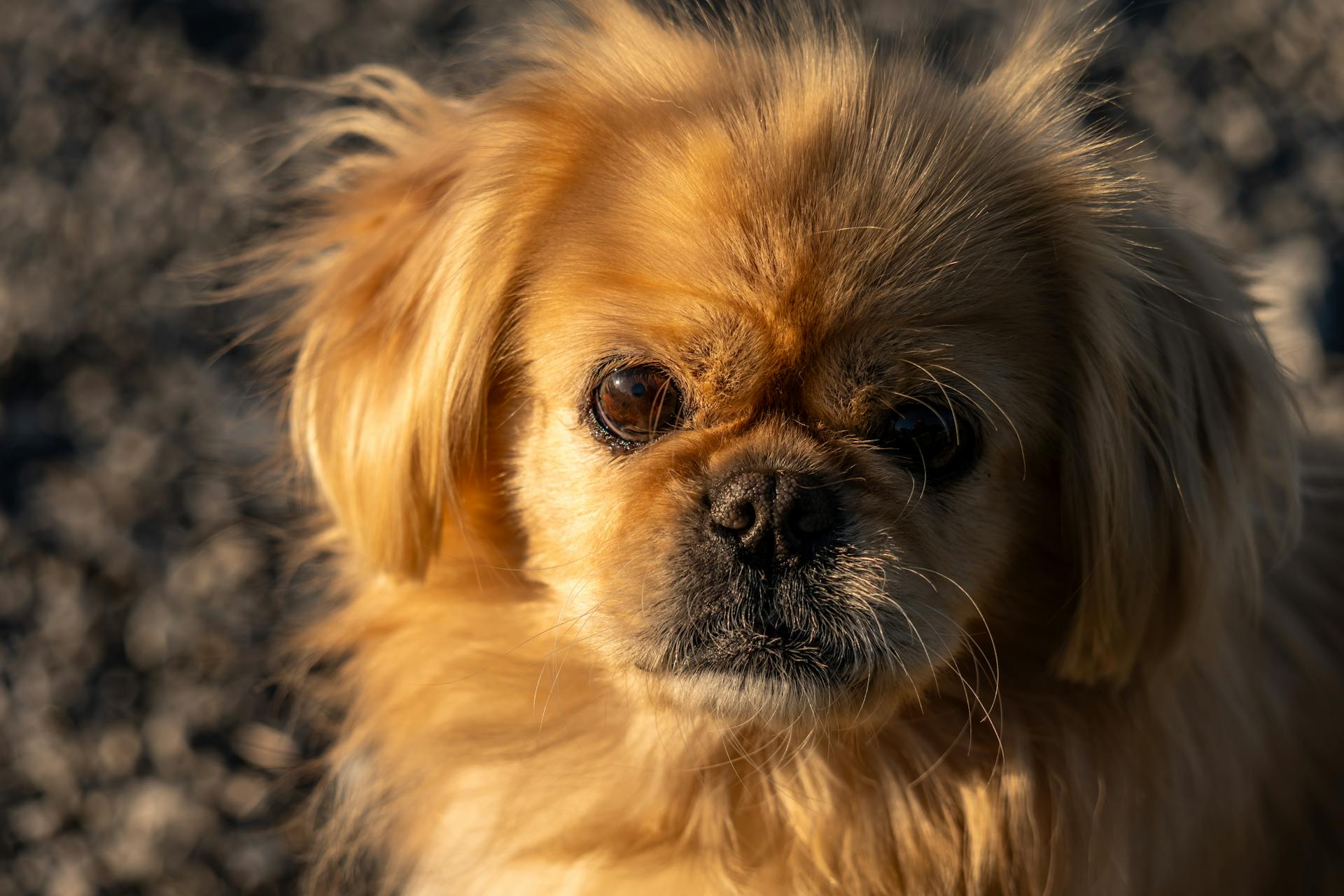
If you're considering adopting a Silky Terrier, you're in for a treat - these dogs are known for their friendly, outgoing personalities and silky coats that require regular grooming.
Silky Terriers are a small breed, weighing between 8-11 pounds and standing about 9-10 inches tall at the shoulder.
They are intelligent and trainable, but can be strong-willed at times, requiring consistent and patient training.
Silky Terriers are generally healthy dogs, but like all breeds, they can be prone to certain health issues, such as Legg-Calve-Perthes disease and patellar luxation.
Physical Characteristics
The Silky Terrier is a breed known for its refined features and silky coat. They have a medium length coat that's straight, flat, and fine, with a silky texture.
Their ears are small and V-shaped, set high on their head with fine leather. This unique ear shape is a distinctive feature of the breed. Their eyes are free from long hair, with a fine silky 'top-knot' on top of their head.
Their body is moderately long in proportion to their height, with a level topline that's maintained whether they're standing or moving. They have a compact, refined structure with a moderate depth and breadth to their chest.
Expand your knowledge: Top Knot Yorkshire Terrier
Characteristics
The Terrier-like dog has a keen and alert nature, always ready to take on a challenge.
Its medium-length coat is a defining feature, with a refined and slightly crested shape that fits perfectly into its shoulders.
The dog's coat is well-covered with long, silky hair that requires regular grooming to maintain its well-groomed appearance.
A desirable length of coat is between 13-15 cms (5-6 ins) from behind the ears to the set-on of the tail, allowing for a balanced look without impeding the dog's movement.
The front and rear feet should be free from long hair to prevent any obstruction.
A fine silky 'top-knot' is a characteristic feature, but it should not fall over the dog's eyes.
For more insights, see: Smooth Haired Fox Terrier Puppies
Ears
The ears of this breed are small and V-shaped, with fine leather that's entirely free from long hair. This unique characteristic is quite striking.
They're set high on the head, which gives them a delicate appearance.
Body
The body of this breed is moderately long in proportion to its height. It's a key characteristic to look out for.
The topline is level at all times, whether the dog is standing or moving. This is a distinctive feature that sets this breed apart.
The chest is of moderate depth and breadth, which is a nice balance. It's not too shallow or too deep.
The ribs are well sprung and carried well back, which suggests a healthy and athletic build. I've seen dogs with well-sprung ribs and they always seem to be full of energy.
The loins are strong, which is essential for a dog that's likely to be active and agile. A strong loin can make all the difference in a dog's overall performance.
Size
Dogs typically stand between 23 to 26 cms tall at the withers.
Bitches are usually slightly shorter than dogs.
In proportion to their height, they should weigh accordingly.
Temperament and Family
The Silky Terrier is no mellow lapdog. They are often bold, feisty, inquisitive, and playful, ever ready for action—a terrier at heart.
Their energy level is quite high, ranking level 4 out of 5, so they require plenty of exercise and mental stimulation. This means they need regular walks, playtime, and training sessions to keep them happy and healthy.
Silky Terriers are clever dogs, but they can be stubborn at times. This means they require patient and consistent training, and a experienced owner who can handle their strong will.
They tend to bark a lot, so if you're looking for a quiet companion, a Silky Terrier might not be the best fit. However, if you're willing to deal with their vocal nature, they can make wonderful family pets.
Here are some key temperament traits to consider:
- Bold and feisty
- Inquisitive and playful
- Assertive toward other dogs or pets
- Clever but stubborn
- Tendency to bark a lot
Overall, Silky Terriers are lively and engaging dogs that thrive on attention and interaction. With the right owner and plenty of exercise, they can make wonderful companions for active families.
Care and Upkeep
As you consider adopting a Silky Terrier from a rescue, it's essential to understand their care and upkeep needs.
Silky Terriers are active breeds requiring a moderate amount of exercise, which can be met with a daily walk on leash or indoor games.
They also enjoy having the freedom to explore a safe area, such as a fenced yard, where they can use their keen sense of smell.
Regular grooming is a must, as their coat requires brushing or combing every other day to prevent matting and tangling.
Upkeep
This breed needs regular exercise to stay happy and healthy. They require a moderate walk on leash, but they really thrive when they get to explore and sniff around on their own in a safe area.
A fenced yard is a must-have for this breed, as it gives them the freedom to roam and play without worrying about their safety.
Their coat needs some TLC, with daily brushing or combing every other day to prevent matting and tangling.
Health
When taking care of your furry friend, it's essential to be aware of potential health issues that may arise.

Major health concerns in these animals are relatively rare, but it's good to be informed.
Minor health concerns include patellar luxation and Legg–Perthes, which can be painful for your pet.
These issues may require veterinary attention to prevent long-term damage.
Some other health issues that can occur in these animals include diabetes, epilepsy, tracheal collapse, allergies, and Cushing’s.
These conditions can be managed with proper care and treatment, but it's crucial to catch them early.
Regular check-ups with your veterinarian can help identify any potential health issues early on.
Suggested tests include knee and eye exams, which can help detect problems like patellar luxation and eye conditions.
On average, these animals can live for 11–14 years with proper care and attention.
Expand your knowledge: Yorkshire Terrier Puppy Care
Sources
- https://www.akc.org/dog-breeds/silky-terrier/
- https://www.thekennelclub.org.uk/breed-standards/toy/australian-silky-terrier/
- https://www.petfinder.com/dogs-and-puppies/breeds/silky-terrier-dogs-puppies/
- https://silkyrescue.org/adoptionfaq.htm
- https://givefreely.com/charity-directory/nonprofit/ein-263882331/
Featured Images: pexels.com


